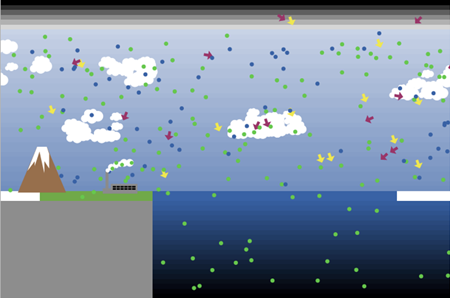Global temperatures in the year 2010 are on course to be the highest ever in 130-year record. This is the consensus of recent three different analyses by NASA, National Oceanic and Atmospheric Administration’s National Climatic Data Center and a joint record kept by Britain’s Met Office and the University of East Anglia. While these results do not prove that the long-term trend will continue, the conclusions add to a growing mountain of data and models that do predict catastrophic global temperature rise over the next half-century. Scientists who specialize in climate have carefully weighed all the evidence and an overwhelming number agree.
 A snapshot of the stylized model of the atmosphere and oceans that students can investigate from the High Adventure Science activity on Climate Change. Programmed in NetLogo by Bob Tinker.
A snapshot of the stylized model of the atmosphere and oceans that students can investigate from the High Adventure Science activity on Climate Change. Programmed in NetLogo by Bob Tinker.
There is a rising chorus of “deniers,” people who deny the data and projections. These are not skeptics who look at the data and draw serious opinions. Serious skepticism is an important part of science. The deniers are “contrarian scientists, free-market think tanks, and industry [spokesmen, who have] created a paralyzing fog of doubt around climate change.” The deniers claim, without proof, that the scientific case has not been made, that certain scientists are lying, even though investigations have cleared them, assert that climate change is benign, and even claim that the covenant God made with Noah will protect us. This is not science, it is propaganda.
The public is confused about these public debates and is increasingly convinced that they reflect true scientific uncertainty. Gallup polls show the percent of the population that thinks that the seriousness of global warming is generally exaggerated has grown from 30%in 2006 to 41% in 2009.
It is important to go to the root of the problem: a poorly educated nation that is unequipped to tell the difference between science and propaganda. An example of what is needed is an engaging activity we created on climate that is designed to help students understand the possible causes of climate change and appreciate the issues involved. Our key innovation is an interactive model that incorporates many of the important factors that influence climate such as clouds, CO2, water vapor, ice sheets, ocean absorption of greenhouse gasses. Students can learn for themselves about the interactions of these factors by experimenting with the model. The model is not intended to be predictive—that requires the most powerful computers that exist—but it does illustrate many of the dynamic features in the scientist’s models.
Materials based on this model should help students understand the science, but science educators need to go one step farther and help students understand the difference between science and propaganda. We need to engage students in thoughtful debate about the issue so they can form their own opinion. We should care less about what those opinions are than that they are backed by an understanding of the science and the process of science. This is why every student needs a better understanding of science.